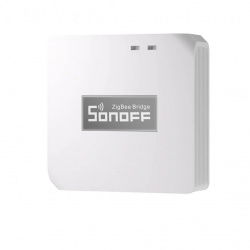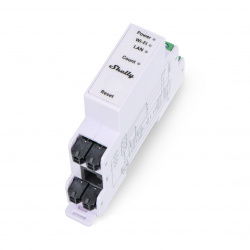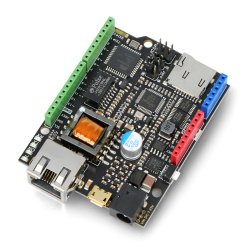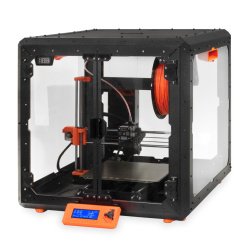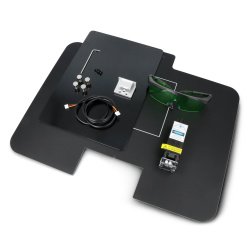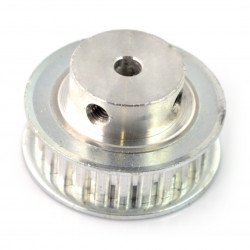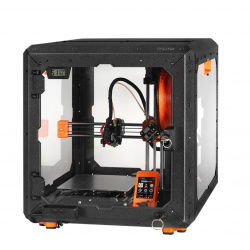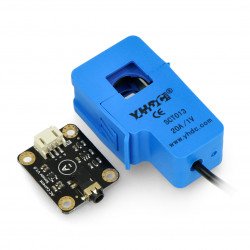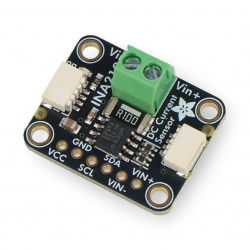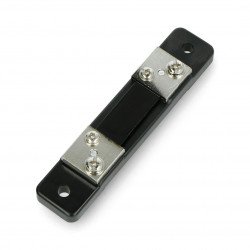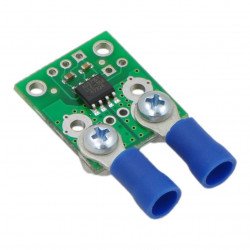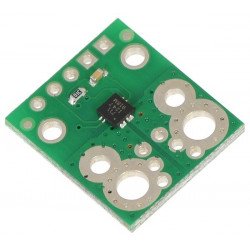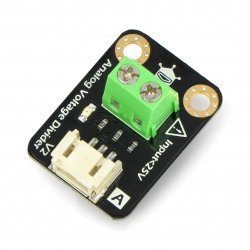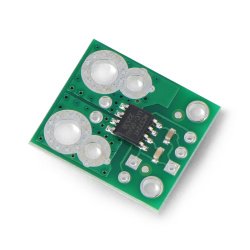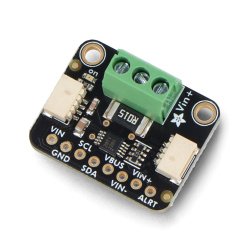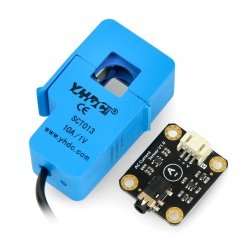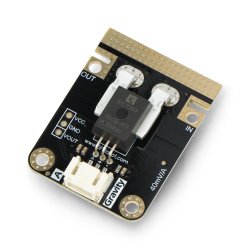Among the various sensors, current sensors are the most widely used. This is due to the fact that they are devices that are useful almost everywhere. They are used to measure the consumption and intensity of electric current both at home and in factories. They are used by large and small companies, individuals, public places and of course all DIY enthusiasts!
Current sensors
Voltage divider 5V/25V for Arduino
A voltage divider is used, when the measured voltage has a larger value than the A/D converter's range. The device works in the range from 0 V to 25 V. The output voltage has a...DFRobot Gravity: Analog AC Current Sensor SCT 013-020 - to 20A
The sensor measures the intensity of the current flowing in a pipeline without its opening. Measurement occurs through the insulation on a single wire, and the output is the...DFRobot Gravity v2.1.0 - I2C Digital Wattmeter
A module that allows you to measure electric energy consumption of up to 26 V / 8 A. The maximum measurement error is approx. 0,2%. It communicates through an I2C interface. It...AC current sensor SCT 013-100 - to 100 A
The sensor providing the measurement of alternating current flowing in the pipeline without the need to pull off the isolation. The measurement occurs through the insulation on...Grove AC-Voltage sensor - RMS AC voltage sensor - MCP6002 - Seeedstudio 101991032
The sensor is equipped with the MCP6002 system and is designed to measure the rms value of AC voltage . It has adjustable gain for various voltage inputs from 120 V to...Bidirectional current / power sensor - INA219 - 26V 3,2A - STEMMA AT / Qwiic - Adafruit 904
Bidirectional current and power sensor manufactured by Adafruit. It has an embedded INA219 chip, two STEMMA QT / Qwiic standard connectors located on both sides of the...DFRobot Gravity - Hall magnetic field sensor
The magnetic field sensor with digital output OH9249. It is supplied with the voltage of from 3.3 V to 5 V, it works with Arduino modules.Gravity: Conductivity Sensor Switch - DFRobot
The module that is able to determine whether the object has an electric conductivity. The maximum detection value is 10 MΩ. After electric conductivity detection, the module...Voltmeter KWS-AC300 with split-core current transfer - 50-30V/100A
The KWS-AC300 is a closed-core AC transformer that allows you to measure current parameters. A small LCD display shows data indicating voltage and current, temperature,...- Reduced price
- SPECIAL OFFERS
ACS724 current sensor carrier 0A to 20A - Pololu 4044
The ACS724 sensor is a module offering precise measurement of linear current from 0 A to 20 A in one direction. Thanks to the use of technology based on the Hall effect, it...ACHS-7123 Current Sensor Carrier -30A to +30A - Pololu 4032
Current sensor operating in the range from -30 to 30 A, based on the Hall effect. Input voltage is from 4.5 V to 5.5 V. The sensor is designed to use in systems of 5 V.ACS724 current sensor carrier -10A to +10A - Pololu 4043
The ACS724 current sensor is a compact, low-resistance module that is designed to measure current in the range of -10 A to +10 A. Thanks to its built-in electrical...ACS711EX current sensor -31A do +31A - Pololu 2453
Current sensor working in the range of +/- 31 A, based on the Hall effect. The output is an analog voltage. Supply voltage is from 3 V to 5.5 V.DFRobot Gravity - voltage divider 1/5
A voltage divider is used, when the measured voltage has a larger value than the range of A/D converter. The device works in the range from 0,0245 V to 25 V. The output...ACS724 current sensor carrier -30A to +30A - Pololu 4047
The ACS724 module is a compact sensor that offers precise current measurement in the range from -30 A to 30 A. It has a low internal resistance of approximately 1.2 mΩ,...INA228 - current and power sensor - I2C - STEMMA QT / Qwiic - Adafruit 5832
A compact proposition from Adafruit equipped with the INA228 system, which allows you to monitor the power in the circuit. It allows you to measure voltage with a maximum...Current Sensor ACS723 - 5A current sensor - SparkFun SEN-13679
Current sensor operating in the range from 10 mA to 5 A on the basis of Hall effect. The output is an analog voltage. The supply voltage is 5 V.Non-contact voltage detector with flashlight Rebel RB-02
The device allows non-contact detection of alternating voltage from 90 V to 1000 V . Voltage detection is indicated by a change in the frequency of sound generated by the...Grove - AC current sensor TA12-200
The sensor measures the intensity of the current flowing in the pipeline without its opening. Measurement occurs through the insulation on the one wire, output is the current...Gravity - analog AC current sensor - up to 10A - DFRobot SEN0288
An analog sensor from DFRobot that measures the AC current flowing in a wire without cutting it. The measurement range is up to 10 A , and the measurement itself is done...Gravity - analog current measurement sensor - STK-600/M V2 - 50A DC/AC - DFRobot SEN0098-V2
Analog Gravity current measurement sensor from DFRobot, whose task is to monitor and protect the circuit of your project. Thanks to the use of the Hall effect, it ensures...Gravity - analog AC current sensor - up to 5A - DFRobot SEN0287
Analog AC current sensor from DFRobot with a 1 m long probe . It allows you to measure the current flowing in the wire without having to cut it - the measurement is made...See also
- Tilt sensors
- Accelerometers
- Inductive sensors
- Hall effect sensors
- Oxygen sensors
- Optical sensors
- Resistance sensors
- Door sensors
- Piezoelectric sensors
- RPM sensors
- Twilight sensors
- Alarm sensors
- 9DoF IMU sensors
- Pressure sensors
- Air quality sensors
- Sound sensors
- Gesture sensors
- Gas sensors
- Limit switches
- Sensors of light and color
- Magnetic sensors
- Medical sensors
- Pressure sensors
- Sensors odbiciowe
- Distance sensors
- Inductive contactless sensors
- Weather sensors
- Liquid level sensors
- Flow sensors
- Motion sensors
- Temperature sensors
- PT100 temperature probes
- Humidity sensors
- Fingerprint readers
- Encoders
- Photoresistors
- Phototransistors
- IR receivers
- Magnetometers
- Gyros
- Sensor sets
- Grove modules
- Gravity modules
Apart from such important measurable values as voltage, power or current impedance, it is necessary to define the current parameters to describe the phenomena occurring in electrical circuits. These parameters are tested by professional current sensors available in this category. Modern measuring technology enables precise and fast measurement of both direct current and alternating current with regular and irregular waveforms. For this purpose, measuring instruments have been designed which, based on magnetic circuits and semiconductor elements, allow to obtain information about the value of the current flowing in the tested circuit.
The Botland store proposes to buy meters and current flow sensors, which will be ideal elements for building a comprehensive measurement system. They can also come in handy for many other projects!
What is the current sensor? How do electric current sensors work?
Current sensors are commonly used devices. Depending on the type of device, they can act as independent measuring devices or modules that can be added to a given electronic project. In this category you will find many types of current sensors. Devices such as - for example - Grove ACS70331 DC current sensor enable precise measurement of DC / AC � 5 A (direct current and alternating current). The construction of the sensor is based on the giant magnetoresistive (GMR) technology. The sensor measures the current with a basic sensitivity of 200 mV / A. The module is compatible with Arduino and Raspberry Pi. This sensor, as well as many others available in our Botland store, is also used to detect a magnetic field. It uses an integrated, low-resistance primary wire through which the current flows. The modules are compatible with controllers such as Arduino and Raspberry Pi, but they can also work with other parts of programmable electronics.
How to measure electric current?
Before taking any measurement, please read the instructions carefully. When you want to measure the current in an electric circuit, be sure to carefully follow the safety rules to avoid electric shock and damage to the circuit components.
First of all, you must not touch non-insulated circuit elements as they may be live (wrong connection). Secondly, the principle of limited trust towards bystanders and animals should be applied to prevent their unauthorized contact with live parts. If you want to measure the current intensity, disconnect the circuit from the supply voltage and, in the case of circuits with capacitors, wait a few minutes after turning it off to discharge them. Remember to obey all of the specific steps that can be easily found in the manufacturer’s manual.
When connecting the ammeter directly to the circuit, it is necessary to determine for which element you want to measure the current intensity. Then, the measuring system should be connected in series with this element. If the current flowing in the circuit exceeds the allowable measurement range, a voltage divider, inductive current transformer or semiconductor sensor should be then connected. The obtained measurement data can be sent to the analog input in the Arduino or Raspberry Pi electronics. Thanks to this you can implement, for example, overcurrent protection that controls the relay, or a measurement system that monitors electricity consumption.
Current sensors and Hall effect
Some more advanced sensors measure the current using the so-called Hall effect. An excellent example are the sensor modules manufactured by Pololu. With these devices you can monitor the power consumption of receivers and detect the load connected to the network. It is also possible to implement short-circuit and overload protection.
In the case of Pololu sensor modules, the analog output enables the sensor to be connected to the Arduino. Thanks to this, it is possible to read the voltages representing the current in the tested circuit in a very convenient way. Full compatibility with Arduino and other programmable electronics is an advantage for many other reasons as well. If, on the other hand, you want to measure alternating current in many places of the circuit, then a good solution is to use the SCT 013-030 sensor, which allows you to measure sinusoidal alternating current with RMS value up to 30A, without disconnecting the tested circuit.































































































































































































































































































































